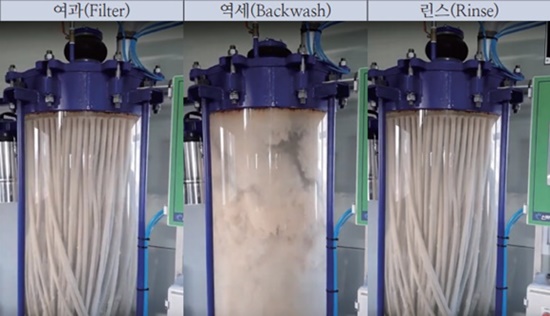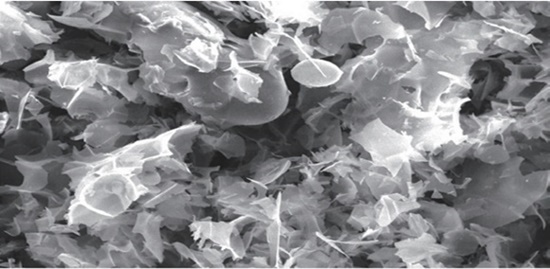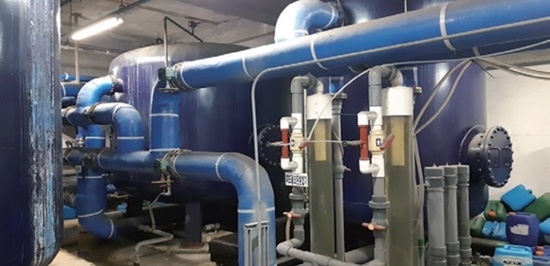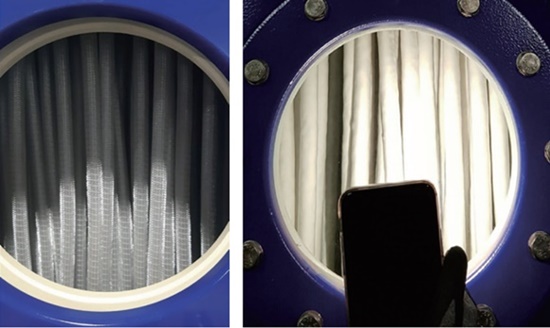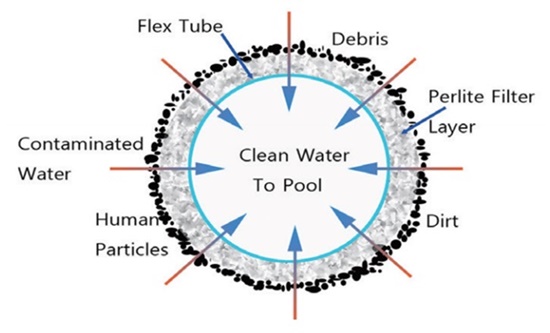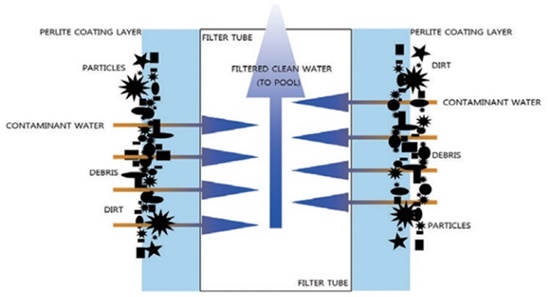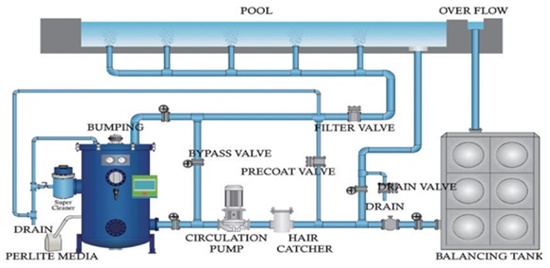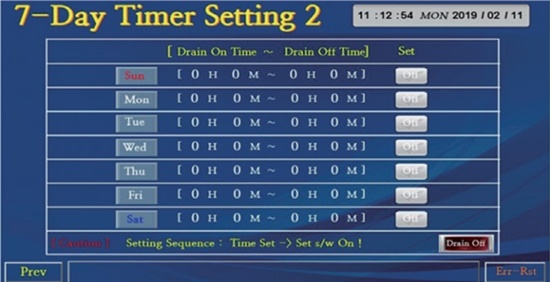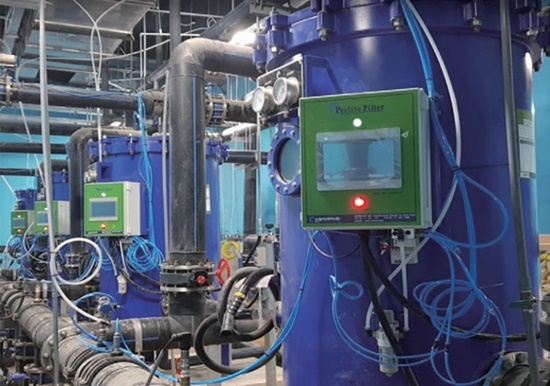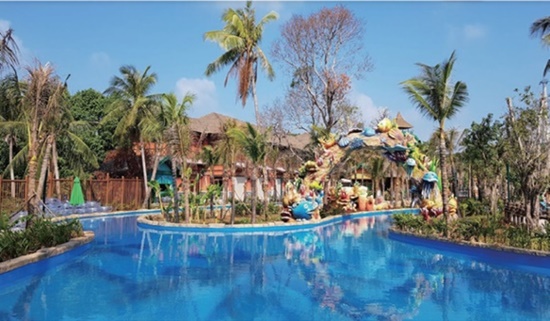[기고] 진주암(Perlite)을 이용한 수영장 수처리 시스템 (3)
글_박규백 신화아쿠아(주) 전무이사라펜트l기사입력2020-12-02
진주암(Perlite)을 이용한 수영장 수처리 시스템 (3)
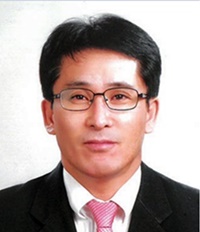
글_박규백 신화아쿠아(주) 전무이사
3. 진주암여재(Perlite Filter Media)
진주암(Perlite)은 화산작용으로 생성된 규산질의 암석을 순간적으로 850°C~1200°C에서 가열, 팽창시켜 생산하는데, 팝콘처럼 팽창된 원석 내부에 무수히 많은 미세기공이 생성되기 때문에 질량이 매우 낮다. 원석의 약 20배로 팽창된 진주암은 백색 또는 유백색의 불활성 분말 형태로, 인체에 무해하며 불연, 흡음, 흡습 및 강한 흡착력을 가지기 때문에 건축자재 및 음료수, 포도주, 맥주 등 주류, 의약품 제조 시 정밀여과용으로 활용된다.
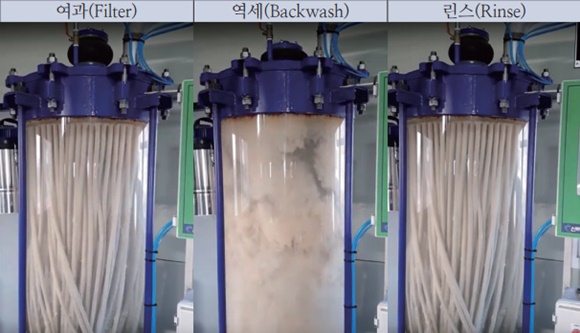
[표 3] 진주암여과기의 작동 사이클 도해(Pilot System)
진주암은 미국 Food Chemicals 'CODEX' 및 한국 '식품공전'에도 등재된 안전한 식품첨가물이며, 물에 맛, 냄새, 색 등의 변화를 일으키지 않고 중금속이나 여타의 인체 독성이 전혀 없기 때문에 세계적으로 다양한 분야에서 광범위하게 사용된다.
진주암은 용도에 따라 다양한 입도(Granule Grade)로 생산이 되며 수없이 많은 미세기공으로 인해 요구수질에 따라 0.1 ㎛ 단위의 정밀여과가 가능하다. 수영장용으로는 Darcy 값 2.1 ~ 3.4의 투수성(Water Permeability)에 약 44 ㎛ ~ 150 ㎛(Wet Sieve Method)의 입도를 사용하여 1 ㎛급의 여과성능을 제공한다.
진주암은 고열 처리된 불활성 미네랄로 물이나 화학성분에 녹지 않으며 압축이 되지 않기 때문에 형성된 여과막이 굳어지지 않고 쉽게 분리된다.
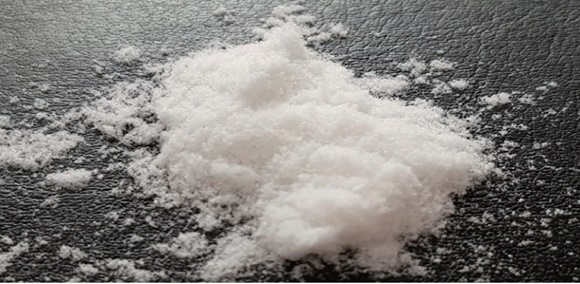
[그림 6] 진주암(Perlite Media)
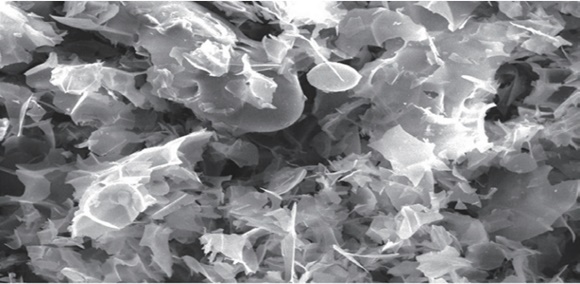
[그림 7] 진주암 전자현미경 사진, 출처 : Perlite Institute.org
4. 진주암여과기(Perlite Filter)
(1) 진주암여과기의 분류
진주암여과기는 프리코트여과기(Precoat Filter)의 한 종류에 속한다. 이 종류에 속하는 것은 진주암 말고도 규조토(Diatomaceous Earth. D.E), 폴리에스터 파이버(Polyester Fiber), 셀룰로즈(Cellulose)여과기 등이 있는데, 진주암여과기는 프리코트 타입여과기 중에서도 다시 여재재생형여과기(Media regenerative Filter)로 차별화된다.
같은 프리코트 타입여과기라 해도 한 번 사용한 여재를 버리고 다시 채워(Refill) 여과능력을 재생하는 다른 여과기들과 달리 진주암여과기는 사용했던 여재를 수차례 재생(Regeneration)하기 때문이다.
(2) 진주암여과기와 다층여과기의 비교
진주암여과기는 내부에 수직으로 설치된 수백~천 개 이상의 필터 튜브 표면적이 전부 여과면적이 되므로 동일 여과용량의 다층여과기 대비 설치면적이 1/4로 감소하여 기계실 건축비용을 절감할 수 있고, 70 % 이상의 물과 약품, 열에너지를 절약한다.
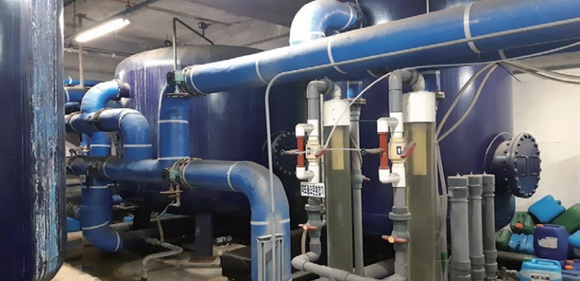
[그림 8] 다층여과기 설치사진
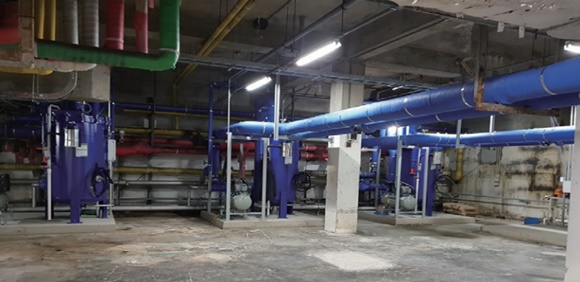
[그림 9] 진주암여과기로 교체 후
진주암여과기는 내구수명이 다층여과기 대비 두 배 이상 늘어나, 수명을 다한 여과기를 철거 폐기하고 재설치하는 공사비를 절감할 수 있으므로, 장기수선계획 측면에서도 매우 유리하다.
수명이 다한 다층여과기를 철거한 뒤 동일 용량의 진주암여과기를 설치하는 사례를 살펴보면 쉽게 확인할 수 있다. 가장 먼저, 거대한 철제탱크가 사라지면서 협소하던 기계실 공간을 넓고 쾌적하게 사용할 수 있고 관리자의 동선이 줄어든다. 장비의 운전상황이 각각의 터치스크린에 표시되며 간단한 터치로 원하는 작업을 수행하기 때문에 간단한 교육만으로도 장비를 운영할 수 있고 관리가 수월하다.
각각의 진주암여과기에는 개별 컨트롤 시스템이 적용되어 여과순환(Filter), 프리코트(Precoat), 여재재생(Regeneration)등의 모든 과정이 자동으로 운영된다. 또한, 시즌에 따라 요일별로 프로그램한 계획에 의해 적정 환수량만 배수할 수 있어 버려지는 물의 양이 획기적으로 줄어들게 되어 약품과 열에너지도 절약할 수 있다.
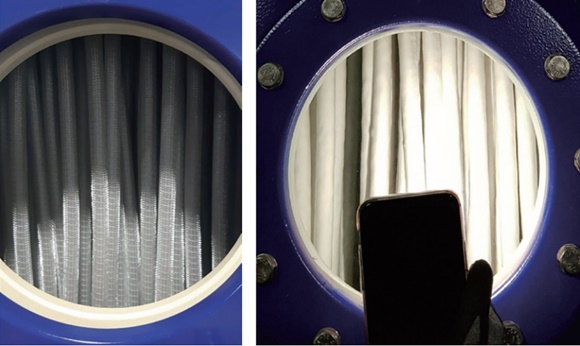
[그림 10, 11] 진주암여과기 플렉스 튜브 / 진주암 여과막 형성 후
(3) 진주암여과기의 여과 메카니즘
위의 그림처럼 수백 개의 플렉스 튜브를 각각 감싸도록 형성된 진주암여과층을 통과하는 과정에서 물속의 이물질이 걸러지게 된다.
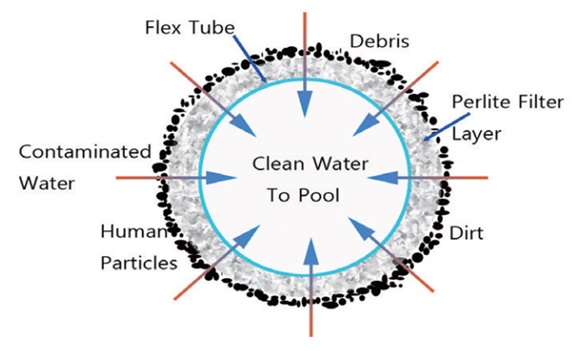
[그림 12] 진주암여과층 평단면
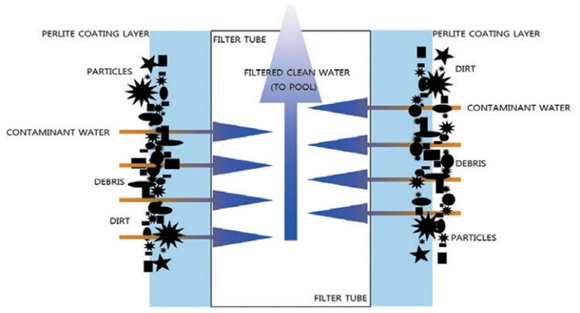
[그림 13] 진주암여과층 입단면
진주암여과기 시스템은 일반적인 '역세'의 과정 대신 매일 1회~2회 ‘범핑(Bumping)’이라는 프로그램에 의한 재생절차를 수행하는데, 다수의 필터 튜브로 구성된 튜브 시트(Tube Sheet)를 본체상부에 설치된 기계장치(Bumping Unit)를 이용하여 상/하로 움직여 튜브에 부착된 진주암코팅층을 털어낸 뒤 이를 다시 코팅하는 방법으로 여과성능을 재생(Regenerate)하는 것이다. 재생(Regeneration) 과정에서 물이 전혀 소비되지 않기 때문에 다른 여과방식들보다 친환경적이고 혁신적으로 에너지를 절약할 수 있다.
이 과정에 대한 가장 많은 궁금증은 “걸러진 이물질은 어디로 가는가?” 일 것이다. 진주암여재의 공극에 흡착된 이물질은 ‘범핑’ 동작 시 여재와 함께 탈리되었다가 프리코트(Precoat)단계에서 여재의 일부가 되어 진주암과 함께 필터층을 구성하게 된다. 한 번 걸러진 이물질은 다시 풀로 올라갈 수 없는 구조이므로 물의 재오염을 우려할 필요는 전혀 없다.
진주암여재에 흡착된 이물질이 축적(Accumulate)되어 공극이 포화상태(Saturation Status)에 이르면 진주암이 여재로서의 수명을 다한 것으로 봐야 한다. 이때는 점검창을 통해 여과막의 오염정도를 간단히 파악할 수도 있고, ‘범핑’ 동작 이후의 차압(Differential) 개선여부를 체크해 봐야 한다. 차압이 줄어들지 않을 때는 진주암여재를 교체한다.
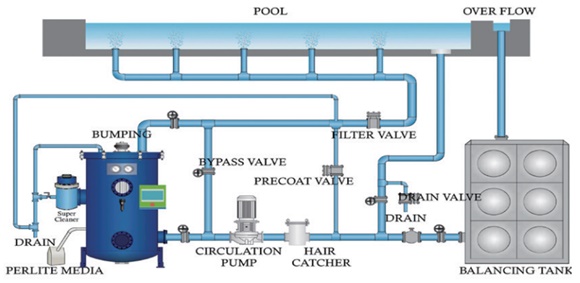
[그림 14] 진주암여과기 시스템 계통도
미국질병통제예방센터(CDC)에서는 “수영장여과 시스템은 물속에 용해된 유기 오염물질과 무기물을 걸러내지 못하므로 운영자의 계획에 의해 일정량의 농축된 물
을 비우고 신선한 물로 치환(Replenish)하는 것이 필수적이다”라고 발표했다. 수영장에 사용인원이 많아지게 되면 물속에 오염물질이 축적되므로, 여과순환 만으로
는 깨끗하고 안전한 최상의 수질을 유지할 수 없고, 시수의 적절한 치환이 필수적인 것이다.
인체로부터 물에 유입된 유분, 타액, 땀, 소변 등은 물속에 용해되어 수영장여과 시스템으로 걸러내지 못하며 암모니아 성분이 염소분자와 결합하여 클로라민(Chloramine)을 생성하기도 하는데, 이것이 기화되면 불쾌한 냄새가 나고 피부자극, 안구자극 및 호흡기자극을 유발할 뿐 아니라 수영장의 공조 시스템, 금속배관을 부
식시키기도 한다. (CDC 발행 Health Hazard evaluation report 2008)
진주암여과기 시스템은 이러한 문제에 대한 해결책을 사전에 마련하여 프로그램에 의해 자동으로 적정량의 수영장 물을 배출하고 신선한 물을 수영장에 보충하는 솔루션을 제공한다.
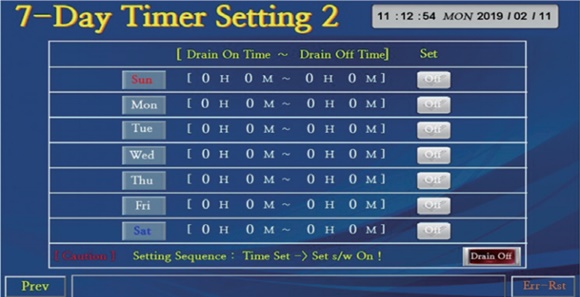
[그림 15] 진주암여과기 시스템 자동 배수 프로그램
이 시수 치환 프로그램의 목적은 역세수 배출량에 비례하는 수동적 시수의 치환이 아닌, 치환이 필요한 적정량만을 시스템에서 능동적으로 제어하여 최고의 수질을 효율적으로 이루어 냄으로써 불필요하게 버려지는 물을 최소화하는 것이다.
(4) 진주암여과기의 현장적용 현황
진주암여과기는 다수의 대형 워터파크, 리조트, 수영장 등에 채택되어 그 우수성이 증명되고 있고, 더불어 러시아, 필리핀, 중국, 베트남 등 세계 각국의 수처리 현장으로 수출하는 성과를 올리고 있다.
최근 개장한 베트남의 대형 워터파크의 사례를 보면, 진주암여과기의 수처리 성능을 확인할 수 있다. 섬에 위치한 워터파크의 특성상 물 공급이 제한적일 수밖에 없고, 이러한 물 부족 극복을 위한 방편으로 진주암여과기가 선정, 시공되었다. 워터파크 오픈일정에 맞춰 해수 담수화 설비를 풀가동하여 수영장에 물을 담수하던 중, 담수화 설비가 고장이 나서 더 이상의 물 공급이 불가능하게 되었다. 다급해진 발주처는 고육지책으로 육지에서 물을 사다가 배로 실어날라 풀에 물을 채워 넣고 있었는데, 안 그래도 어려운 상황에 설상가상으로 빗물과 함께 토사가 풀로 흘러들어 그 귀한 물이 황토색으로 변한 것이었다.
육지에서라면 물을 버리고 새로 받는 것이 당연했겠지만, 다급한 일정 속에 다시 물을 공수할 시간은 없고, 담수화 설비는 고쳐지지 않은 상황에서 유일한 대안은 여과기로 물을 필터링하는 방법밖에 없었다. 일단 토사가 유입된 풀의 여과기를 가동하며 지켜보기로 했는데, 여과기 운전 48시간 만에 물을 완전히 정화 시키는 데 성공하여 발주처에 장비에 대한 신뢰도와 가치를 증명해주는 계기가 되었다.
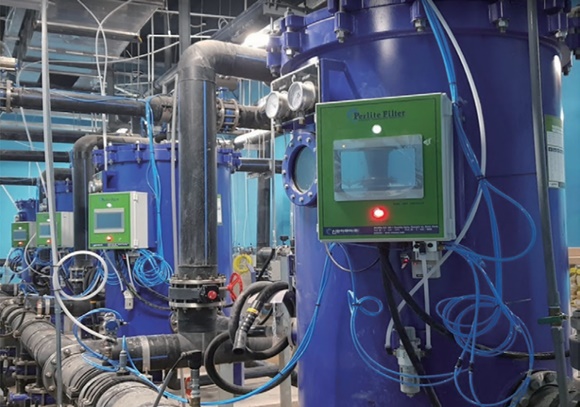
[그림 16] 베트남 워터파크에 설치, 가동 중인 진주암여과기
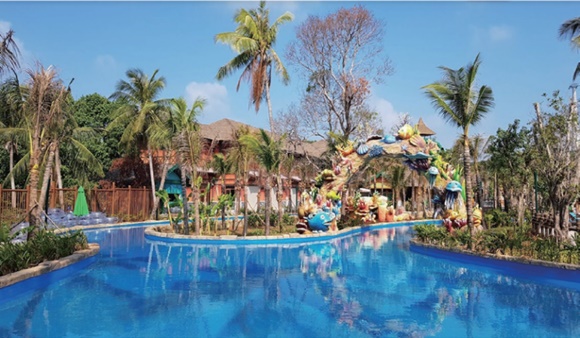
[그림 17] 정화 완료된 유수풀
3. Perlite Filter MediaPerlite is produced by taking rocks of silicic acid that were generated from volcanic activity and heating them for a short period at a temperature of 850°C~1200°C.[Table3] Diagram of the operational cycle of perlite filters (PilotSystem)The rock is then expanded like popcorn, with many fine pores inside. This ensures the mass is very small. Perlite that is expanded to approximately 20 times the size of its original rock takes on the form of white or off-white inactive powder which is harmless to the human body. It is non-inflammable and has great efficacy in absorbing noise and moisture, as well as a high adsorptive power, making it ideal to be used as construction material or fine filtering material in the manufacturing of beverages, wine, beer or pharmaceutical products.Perlite has been listed as a safe food additive under the U.S. Food Chemicals 'CODEX' as well as its Korean equivalent. It does not cause changes in the taste, odor or color of the food, nor does have any toxicity, nor is it considered a heavy metal. This has allowed it to be widely used in various fields worldwide.Perlite is produced in granule grade according to its use. Due to the numerous fine pores, it can filter out matters as small as 0.1 ㎛ to meet the water quality requirements. For those used in swimming pools, a water permeability of 2.1 ~ 3.4 in Darcy value and approximately 44 ㎛ ~ 150 ㎛(Wet Sieve Method) infineness are applied to offer a filtering level of 1 ㎛.Perlite is an inactive mineral that has been treated at a high temperature and does not dissolve in water or in chemical solutions. Nor can it be compressed, which prevents the filter film from solidifying and enables easy detachment.
[Image 6] Perlite Media
[Image 7] Microscopic image of perlite. Source:Perlite Institute.org4. Perlitefilter(1) Classification of perlite filtersPerlite filters fall into the category of pre-coat filters. Other pre-coat filters include filters using diatomaceousearth or D.E.,polyesterfiber, or cellulose. Perlite filters stand apart from other pre-coat filters in that it is in the sub-category of media regenerative filters.This is because unlike other pre-coat filters that throw away the filtering material and refill it, filters using perlite can regenerate the filtering material multiple times.(2) Comparison of perlite filters and other multi-layered filtersIn the case of perlite filters, the surface of hundreds of, or more than a thousand filter tubes serve as the filtering surface. This allows the area needed for installation to be only a quarter of that for multi-layered filters with the same filtering capacity. This saves costs of constructing the machinery room and conserves water, chemicals and thermal energy by more than 70%.
[Image 8] Multi-layered filter that has been installed
[Image 9] After replacing it with a perlite filterPerlite filters have a useful life that is twice as long as multi-layered filters, which helps save the costs of replacing filters. This offers an advantage in long-term repair and maintenance planning, too.This is easily verified by cases where an obsolete multi-layered filter is removed and replaced by a perlite filter.First, the huge steel tank is removed, making the machine room to become more pleasant and roomy. It also reduces the route of movement for the manager. The operational status of each equipment is displayed on the touch screen and is easily manipulated with a simple touch. This makes it easy to train personnel and maintain the equipment.Each perlite filter has a separate control system to have the steps of filtering, pre-coating and regeneration done automatically. Depending on the season or day of the week, a different program can be applied to let out an appropriate amount of water, dramatically reducing the amount of water thrown out, and thus saving chemicals and thermal energy.
[Image10&11] The flex tube of a perlite filter/ After the filter film has been formed for the perlite filter(3) The filtering mechanism of perlite filtersAs water passes through the perlite filter layer that is formed with hundreds of flex tubes wrapping around as shown in the image above, foreign matter in the water is filtered out.
[Image12] Cross section of the perlite filter layer
[Image13] Cross section of the perlite filter layerIn the perlite filter system, instead of ‘backwashing’, there is a ‘bumping’ step that occurs once or twice a day for regeneration. The bumping unit has tube sheets attached to the top part, and the tube sheets consist of multiple filter tubes. The bumping unit is moved vertically to dust off the coated layer of the perlite to recoat it for the regeneration. During the regeneration process, no water is consumed, making it environment-friendly and innovative for its energy conservation properties.One of the most common questions concerning this step is, “Where does the filtered foreign matter go?” The foreign matter adsorbed by the perlite detaches with the filtering material during the bumping process, then becomes a part of the filtering material with the perlite during the pre-coat step. Since the foreign matter, once filtered, cannot backflow into the pool, there are no concerns of water becoming re-contaminated.When the foreign matter adsorbed into the perlite filtering material accumulates and makes the pores saturated, it should be assumed that the perlite’s life as a filtering material has come to an end. When this happens, the degree of contamination on the filtering film can be checked through the inspection window. Whether the differential in pressure after the bumping step is improved also needs to be checked. When the differential does not decrease, the perlite filtering material must be replaced.The U.S. CDC noted that “The filtering system of swimming pools do not filter out organic or inorganic contaminants dissolved in the water. Therefore, it is essential that the operator has a plan to remove a certain amount of concentrated water and replenish it with fresh water according to a plan.”If the swimming pool becomes crowded more contaminants accumulate in the water and thus filter circulation is not sufficient to maintain water quality that is clean and safe. As such, replenishing with fresh water is essential.
[Image14] Perlite filter systemThe body oil, saliva, sweat and urine from the human body that is dissolved into the water cannot be filtered by the filtering system for swimming pools and sometimes combines with chlorine molecules to generate chloramine. When chloramine evaporates, it generates an unpleasant odor and irritates the skin, eyes and respiratory system. It also corrodes the air purification system and metal pipes in the swimming pool(HealthHazard evaluationreport2008, published by CDC).The perlite filter system prepares solutions to such issues in advance by having a program automatically discharge an appropriate amount of water from the swimming pool and replenish it.[Image15] The automatic water discharge program for the perlite filter systemThe objective of this water replenishing program is to achieve the highest efficiency in maintaining the highest water quality by proactively managing the replenishing of an appropriate amount of water, instead of a manual replenishing that occurs in proportion to the amount of backwashing water discharged, and thus minimize waste of water.(4) Application of the perlite filterPerlite filters are adopted by numerous large-scale water parks, resorts and swimming pools and have proven to be of superior quality. They have also been exported to various establishments in Russia, the Philippines, China and Vietnam requiring water treatment.The case of a large-scale water park in Vietnam that has recently opened confirms the water treatment function of the perlite filter. Given that the water park is located on an island, water supply is limited. The perlite filter was chosen to address the water shortage. A desalinization facility was run at full steam before the opening of the water park to provide water to the swimming pool. But in the process the desalinization facility broke down, making it impossible to further supply water. Faced with this urgent situation, the client went so far as to purchase and ship water from the mainland to fill the swimming pool. But to add insult to injury, rainfall made soil to flow into the pool.If the pool had been located on the mainland, it would have been natural to remove all the existing water and replenish it with fresh water. But there was no time to do so with the short deadline. The desalinization facility was still out of order, so the only alternative was to filter water.They first decided to operate the filter for the water that had been mixed with soil and wait and see. Within 48 hours, the water was completely purified, which led to the filtering system gaining complete trust from the client.
[Image16] Perlite filter installed and operated in a Vietnamese water park
[Image17] A pool that has completed water purification
